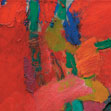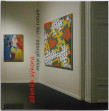exhibitions
The exhibition in the Karlovy Vary Art Gallery is a presentation of the landscape work of Zdeněk Sýkora, and follows two other exhibitions devoted to the same artist in the present year, in the City Gallery Prague and the Museum of Art in Olomouc. In the Prague exhibition, the artist’s landscape work was mentioned, but more as a point of departure from which his most widely-known later oeuvre ensued, predominantly the artwork that gave him a reputation as the author of Structures and Lines, a proponent of geometric abstraction and the connection of artwork with digital computing.
Sýkora, however, began his artistic career at the end of the 1940s as a painter of landscapes, and for the decade to follow the landscape was his main theme as well as an inspiring natural setting. During this period, he moved from the realistic depiction of nature through a post-Impressionist pictorial composition to much freer manifestations, on the boundary between impressionism and expressionism. His primary motifs were the areas not far from his native town of Louny, in the shallow valleys past the village of Cítoliby, and one particularly significant theme became the river Ohře. Sýkora’s gradual development of painterly techniques led towards a non-illusionary, colour-field painting, in which the crucial moment was the artist’s encounter with the work of Henri Matisse in the Hermitage at the end of the 1950s. His extensive cycle “Gardens” from the late Fifties and early Sixties marked a definitive liberation from local colouristics and eventually from realistic depiction. His painting “Garden/Composition” from 1961 is already a clear transition to geometric abstraction, which in the years to follow Sýkora linked conceptually to the programming of his painting by computer. Landscape motifs were indeed a theme to which he repeatedly returned during the Sixties, but more as a university instructor with his students, or with members of the local artists’ club in Louny. From the start of the 1970s, though, his returns to landscape-painting and time spent in nature became much more frequent: the landscape formed a kind of inner escape for him, though in a different sense than in the Fifties. Prevalent during this period are themes from the vicinity of Louny, i.e. the Ohře, Cítoliby and the Central Bohemian Mountains, as well as occasional field-trips to natural settings with his students, primarily the fish-ponds near Třeboň or Moldava in the Ore Mountains, as well as occasional coastal scenes from the island of Rügen in eastern Germany. The present exhibit and catalogue, however, only touch upon three of these areas mentioned, not only with respect to the largest representation of artworks, but also with respect to the continuity of motifs between the later work and that from the 1950s. From around the mid-Eighties, Sýkora’s field trips into nature for realistic scenes grew less, and by the start of the 1990s Sýkora’s landscape work had come to a complete end. This section of his oeuvre, created in parallel with his better-known abstract work, has practically remained without consideration from the 1960s, mentioned only in passing or even viewed negatively as a kind of anachronism unusual for an otherwise progressive artist. And Sýkora’s repeated nature-excursions were most often understood as only a practical component of his work as a teacher. It is the intent of the authors of this exhibition and publication to reveal the phenomenon of Sýkora’s landscapes as a integral component of his creative personality: to integrate them smoothly into the context of his development as an artist, and thus symbolically to form a link with Sýkora’s only previous exclusively landscape-exhibition: in the Aleš Hall in Prague in 1952, which was in fact his first solo exhibit.
Jan Samec, 2010







 solo exhibitions
solo exhibitions group exhibitions
group exhibitions